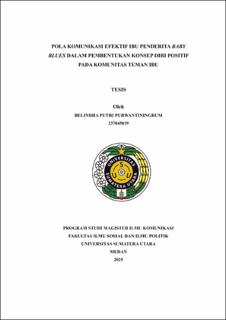Pola Komunikasi Efektif Ibu Penderita Baby Blues dalam Pembentukan Konsep Diri Positif pada Komunitas Teman Ibu
Effective Communication Patterns of Mothers with Baby Blues in Forming a Positive Self-Concept in the Teman Ibu Community

Date
2025Author
Purwantiningrum, Belindha Putri
Advisor(s)
Kurniawati, Dewi
Ramadhani, Emilia
Metadata
Show full item recordAbstract
This study aims to analyze the communication patterns of mothers experiencing baby blues in shaping their self-concept within the Teman Ibu community. The theoretical framework employed includes the Johari Window and Symbolic Interactionism. A qualitative approach using a case study method was applied. Data were collected over a three-month period through in-depth interviews with seven main informants who had experienced baby blues and were members of the Teman Ibu community, along with two additional informants and one clinical psychologist as an expert source. The findings reveal that the mothers' self-concept underwent complex dynamics. Most informants initially displayed a negative self-concept in the early postpartum phase, characterized by low self-worth, guilt, lack of confidence, and difficulty in accepting the maternal role. Over time, this self-concept shifted towards a more positive direction, especially among mothers who received emotional support and open communication from their partners and families. Supporting factors for effective communication included empathy, emotional involvement of the husband, and a safe space for openness. In contrast, hindering factors included avoidance behavior, lack of emotional support, and pressure or interference from extended family members. This study identified a communication pattern referred to as WARMTH (Willingness, Affirmation, Responsiveness, Mindfulness, Togetherness, and Harmony), which represents the desired qualities in communication, such as the husband's willingness to be present and supportive, verbal affirmation, empathetic responses, emotional attentiveness, shared experiences, and a harmonious relationship free from conflict and external pressure.
Collections
- Master Theses [362]
